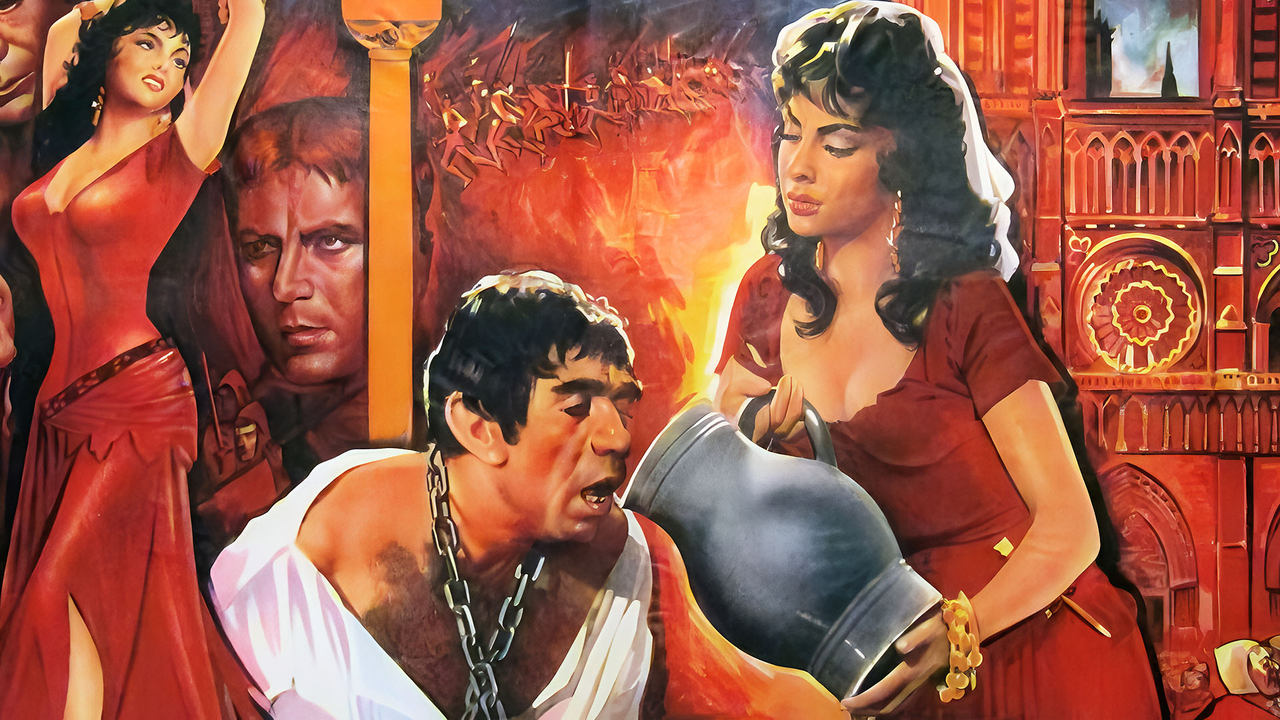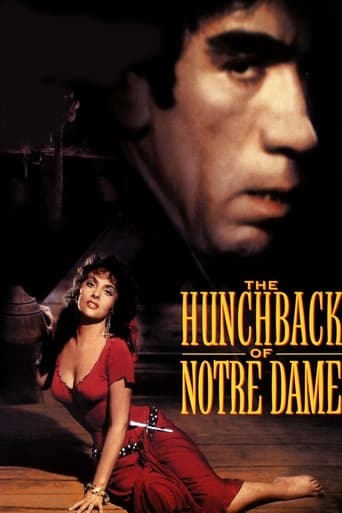

"Notre-Dame de Paris" tells the story of Esmeralda, a beautiful Roma woman, whose beauty seduces countless men in the city of Paris. When a judge, out of jealousy, stabs the leader of the armed guards because Esmeralda falls in love with the man, she is sentenced to death and hides in the great cathedral under the protection of Quasimodo, who lives next to the bell and suffers from a disformed body.The longer I watched the movie, the more I got the feeling that this is a piece of literature that is nearly designated to be played on a stage instead of being forced into a movie. You find many classical elements of a theatre play, even the set design sometimes reminds of one. Otherwise this is of course a very famous piece of literature that delievers all the ups and downs you would expect, which makes for a decent plot. The end in this case wasn't explained very good, it is rather unclear why Quasimodo should stop listening to Esmeralda completely, even when she states that the men only want to save her. But otherwise there's not much to criticize here.All in all this is a classic adaption of a famous novel. I can imagine that in its time, it was a huge effort to film this, nowadays you're not really sitting on the edge of your chair but it still is a well-produced and well-played adaption of Hugo's script.
... View MoreI don't quite understand why this movie is always pulverized in favor of overrated 1939 Hollywoodization or the Disney travesty. Admittedly it needs more "oomph" - some blame director Delannoy, I heretically think problem is Hugo's own novel, which is well-written but hardly exciting story. However, Alain Cuny is excellent as Frollo, and while cutting off the dungeon scene is a mistake, in general the script by Jean Aurenche and Jacques Prévert is pretty faithful to Hugo. Sure, this Esmeralda is not Hugo's sixteen-year-old heroine, but she is one of the most sympathetic versions of the character. I rather take her than some sleazy young girl acting worse than a two franc whore.
... View MoreIt's no wonder that people who have been introduced to the story of "the Hunchback of Notre Dame" by big movie versions, like the 1939 classic or 1996 Disney animation, don't often know what really happens in Victor Hugo's classic book "Notre Dame de Paris". I have seen totally six different movie version of the story, and although none of them is completely bad, only one has actually been really accurate to the events of the book. Although I will always say that the 1939 Hollywood version is the absolute best, this 1956 French/Italian film is closest to the book, as far as plot is concerned. Esmeralda does not fall in love with Gringoire, it's Claude Frollo and not his brother Jehan who lusts after Esmeralda and in the end almost all the main characters die. Yet, in a strange way, it does make some subtle differences also. Esmeralda is not young and innocent girl unaware of the reactions she causes in men. This Esmeralda is more mature, yet even she can't help but fall under Phoebus' charm. Claude Frollo is not an archdeacon, filmmakers probably still afraid of making a priest the villain. Instead he is an alchemist who has lived in the tower of Notre Dame almost his whole life. This is kind of strange since it's said in the film "he is in disgrace with the church". It also diminishes bit of the conflict that happens in him when he becomes obsessed of Esmeralda. Still, I'm sure fans of Hugo can enjoy this version, if they are ready to forgive the few artistic liberties. For a film made in Europe that obviously doesn't have the big budget Hollywood could use, the sets of Notre Dame's cathedral and the 15'Th century Paris are surprisingly well done. Although the low budget does make some scenes suffer, like Quasimodo' "Sanctuary! Sanctuary!"- scene, Jean Delannoy's direction keeps the story going and Georges Auric's music is beautiful to listen to. However some of the English dub does bother in the film that really should have been released in French.The Italian actress Gina Lollobrigida, ones called "the Most Beautiful Woman in the World", plays the more mature and sensual Esmeralda, and she makes it very clear why half the Paris is drooling after her. I was surprised to see how little makeup Anthony Quinn wears as Quasimodo, yet he completely convinces that this person has been seen as a freak his whole life. His performance is very physical, making Quasimodo seem like a beast who tries to be human, instead of Charles Laughton's poetic soul. Alain Cuny is bit too brooding as Frollo, but he does look up to part. Still, I feel screenplay didn't give him enough chances to fully explore the role. Jean Danet as Phoebus is not really anything but a jerk full of himself, but since that's how I see Phoebus I have nothing against him. Philippe Clay seems nothing like the Clopin I pictured from the book, yet there's something about his rather humorous performance that I like. Jean Tissier also makes a very subtle and slimy performance as King Louis XI, who in previous 1939 film was portrayed as a rather good guy. Robert Hirsch as Gringoire is not memorable and Maurice Sarfati as Jehan is simply annoying. Although the 1956 film is neither the best nor the finest version of the story, it does come closest to the book than any other film I've seen and is definitely worth watching. It's not a bad film, yet it could have been far better also.EDIT: I recently saw original French speaking version of this film. I recommend seeing that one. Not only because they speak French so you don't have to bare the horrible English dub, but it also has scenes that were deleted from English cut and Alain Cuny shows a lot more torment and conflict as Frollo.
... View MoreDepending on how you look at it this is either the best "Hunchback" or the worst; for my money Lon Chaney will always be the Quasimodo for me but before I discount this version too much, I'll review its good points.1) It does remain faithful to Hugo's novel; 2) We get to see Quasimodo in color.Now the bad points:1) Quinn acts as though he'd rather be anywhere than making this movie; 2) The dubbing is terrible in some spots; 3) Quasimodo doesn't appear to be hunchbacked; 4) Esmeralda is more sex pot than innocent 16 year old; 5) The musical score leave a lot to be desired.You've got to wonder about Quinn's patience in the make-up chair. His incarnation of Quasimodo isn't really that ugly and does not even come close to the description given by Hugo in his novel. In fact, Lon Chaney and Anthony Hopkins are the only actors that came close to Hugo's description. I kinda thought Quinn's incarnation of Quasimodo resembled a punch drunk boxer --- his Quasimodo just appeared dumb. Beyond Quasimodo and Esmeralda the other characters just never developed.This movie could have been good but everyone from the director to the producers to the actors dropped the ball. Watch this one if it comes on TV but save your money for the Laughton, Chaney or Hopkins version.Here's how I rank the versions of the "Hunchback"1. Chaney (The Master!) 2. Hopkins (Make-up job superb - just like Hugo described him!) 3. Laughton (Brilliant acting job - most powerful flogging scene.) 4. Quinn (It's in color.) 5. Patinkin (This ranking is not necessarily a knock on Patinkin's Quasimodo, it's a knock on the production & writing which does not follow Hugo's novel at all; the sequence of events is all out of order.) 6. Clarke (A BBC Turkey. Shot on video tape with a lower than low budget. I got the feeling I was watching some drama students put on a play their friend recorded.)
... View More